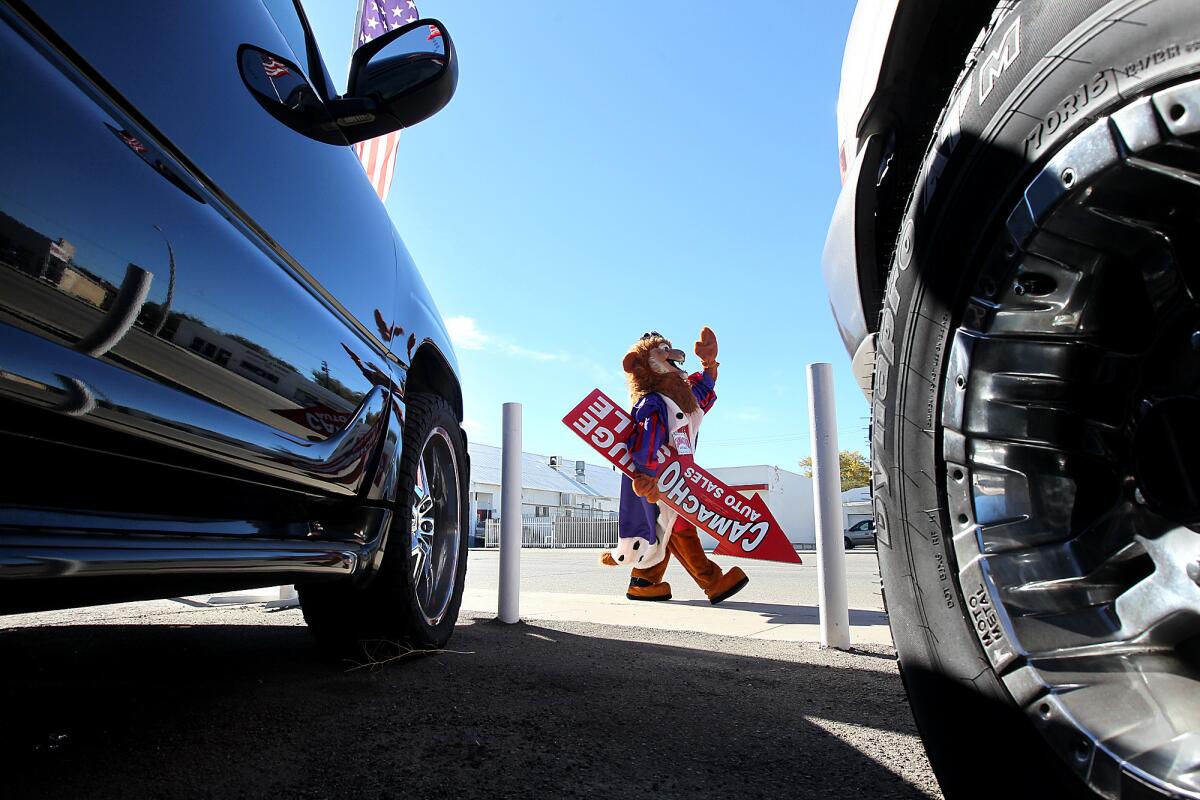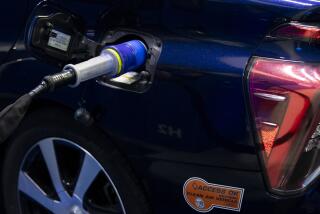A vicious cycle in the used-car business

- Share via
Tiffany Lee wanted a car. She was weary of the two-hour bus ride to her job at a UCLA Health System clinic. She hated having to ask friends to drive her 7-year-old son to his asthma treatments.
But as a single mother with three children, bad credit and a $27,000-a-year salary, she couldn’t find a bank or dealership willing to give her a loan.
Then a friend steered her to Repossess Auto Sales in Hawthorne.
Another buyer might have balked at the deal she was offered. Lee figured she had no choice. She put $3,000 down and drove off in a 2007 Ford Fusion, agreeing to pay $387 a month for four years. The interest rate: 20.7%, nearly triple the national average for a used-car loan.
A year and a half later, Lee fell behind on her payments and filed for bankruptcy. So she was relieved when the dealership called and offered to make her loan more affordable. The sales manager even promised to throw in a free smog check. Lee, 35, drove back to Repossess Auto on a rainy Monday evening, handed the keys to an attendant and sat down with the manager.
Moments later, she said, employees parked four cars tightly around the Ford, blocking it in.
There would be no new deal. Lee’s car was being repossessed. She and her children waited in the rain until a friend could drive them home.
Lee, who described that night as “one of the worst experiences of my life,” had stumbled into the bare-knuckle world of Buy Here Pay Here used-car sales.
In this little-known but fast-growing corner of the auto market, dealers command premium prices for road-worn vehicles and finance the sales at interest rates that can top 30%.
In a kind of financial alchemy, they have found a way to turn clunkers into cash cows and make money off the least creditworthy customers: the millions of Americans who are stuck in low-paying jobs, saddled with debt and unable to qualify for conventional auto loans.
For most of those people, having a car is the only way to stay employed, and they’ll accept almost any terms to get one.
Buy Here Pay Here lots sold nearly 2.4 million cars nationwide last year, up from 1.3 million a decade ago, according to CNW Marketing Research.
CNW estimates that there are more than 33,000 such lots nationwide, compared with about 20,000 dealerships selling new cars. Buy Here Pay Here dealers make $80 billion in loans every year, according to the Federal Deposit Insurance Corp.
Although dealers are loath to open their books, profit margins average nearly 40%, according to a trade group, the National Alliance of Buy Here Pay Here Dealers. That’s twice what new-car dealers make.
Many of the lots require customers to return once or twice a month to make loan payments in cash — hence the term Buy Here Pay Here.
A key reason for the industry’s growth in tough times is that dealers can come out ahead whether or not customers keep up with their loan payments.
About 1 in 4 buyers default. In the real estate and credit card industries, that would be bad news. In the world of Buy Here Pay Here, it’s just another avenue for profit: The car can be repossessed and put back on the lot for sale in short order. A new buyer makes a down payment, takes on a high-interest loan and the cycle starts anew.
Provided they don’t get wrecked, these recycled vehicles just keep paying dividends. At some dealerships, cars have been sold and resold over and over — three, four, even eight times apiece, motor vehicle records show.
What’s more, these hand-me-down wheels hold their value remarkably well. The sale price is sometimes higher the second or third time a car is sold, records show — a testament to the desperation of buyers and the market power of Buy Here Pay Here lots as lenders of last resort.
Default and repossession are so central to the business that many dealers plan on both. They equip cars with hidden GPS devices and remote-control ignition blockers to make the repo man’s work easier.
Many pursue their customers for years after they’ve seized and resold the vehicles. Some keep lawyers on staff, filing dozens of lawsuits each month to recoup unpaid balances and garnish debtors’ wages.
One high-volume dealership, Neil’s Finance Plaza of Kansas City, Mo., has filed more than 6,000 lawsuits since 1995 through an affiliate, seeking unpaid balances from customers who defaulted, records show. The dealership sells about 1,400 vehicles a year.
Those in the business make no apologies for their practices.
“Our customer doesn’t have any money. He doesn’t plan for a rainy day,” Chuck Bonanno, a Buy Here Pay Here consultant in Florida, told dealers at a recent industry conference in Las Vegas. “He isn’t going to pay unless you make him.”
Dealers say they offer a valuable service, giving people with bad credit access to transportation so they can provide for their families.
They contend that the risks inherent in the business are daunting and that profits can be elusive. After each sale, they watch their investment drive off — “money on the street,” as dealers put it — and can only hope the customer doesn’t skip town or go broke.
When a buyer defaults, repossessing the merchandise can be a costly hassle, dealers say. Some cars are never found, and others come back so beaten up they have to be junked. Before a repossessed car can go back on the lot, dealers must go through legal formalities such as giving the customer a chance to redeem the vehicle.
Bob Okeley, who owns a chain of Buy Here Pay Here lots in Indiana, sells about 300 cars a month, nearly twice the business he did five years ago. But he said the increased demand isn’t entirely the result of hard economic times.
Some of his customers earn as much as $90,000 a year and have college degrees, he said. They’re shut out of the conventional loan market not because they’re poor but because they can’t stay out of debt, he said.
Okeley maintains that by reminding customers to make their payments and badgering those who fall behind, his dealership teaches financial discipline.
“We’re helping people manage money that aren’t good at doing it on their own,” he said.
Squeezing hefty payments from credit-challenged people is possible because Buy Here Pay Here dealers don’t use outside lenders to finance their sales.
In a conventional auto loan, the dealer is a middleman. The purchase money is provided by a bank or finance company.
In a Buy Here Pay Here loan, there is no outside money. The cars are sold on installment plans, an approach once common for big-ticket purchases like refrigerators and still widely used by rent-to-own furniture stores catering to people who don’t have credit cards.
The arrangement allows Buy Here Pay Here dealers to make their own rules and set their own interest rates, with far less regulatory scrutiny than mainstream lenders receive.
“This is not the car business. This is the finance business,” said Ken Shilson, an accountant who founded the National Alliance of Buy Here Pay Here Dealers in Houston. “Not everybody has the stomach for it.”
Out of options
Aimee and Chris Cvitanov wound up on a Buy Here Pay Here lot after financial setbacks dented their credit rating.
Chris, 37, was severely burned in a car accident six years ago and hasn’t worked regularly since. Aimee, 30, lost her job in the insurance industry in late 2009. The lease on their Chrysler 300 expired soon afterward, and she needed a car quickly to search for work.
More than a dozen conventional dealerships turned the couple down for a loan. Then they heard an ad on the radio for M.K. Auto Inc. near their suburban Sacramento home.
The Cvitanovs said a salesman collected information to check their credit and told them the only car they qualified for was a 2003 Mitsubishi Galant. It had been driven more than 100,000 miles.
The price was $7,999, according to their sales contract — double the Kelley Blue Book value at the time. The couple said they could manage a $1,000 down payment, and the dealer offered to finance the rest at 25.99%. Their monthly payment would be nearly $290.
The Cvitanovs said they signed the contract, reluctantly, after the dealer promised they could trade it in for something better if they kept up their payments for six months.
When the time came, they exchanged the Mitsubishi for a decade-old Mercedes-Benz E-Class with 80,000 miles, three previous owners and a repossession in its past.
At $13,998, the price was about $5,500 above Blue Book. The balance of the old loan was rolled into a new one, also with an interest rate of 25.99%, according to the new contract. Their payments climbed to $498, stretched out into 2014.
By then, the total cost of the Mercedes with interest would be more than $25,000.
“A couple of years ago, we could have leased a brand-new Mercedes for less money,” Chris Cvitanov said.
The couple made payments on the sedan for six months, trying to renegotiate the loan at the same time.
After those efforts failed, they filed suit in January claiming that they were deceived about the loan terms. The dealership settled two months later. M.K. Auto took the Mercedes back and gave the Cvitanovs a $6,000 credit toward a 2003 Chevrolet Tahoe.
The dealer, Magdi Saad Gendi, did not respond to a request for comment.
Chris Cvitanov, who recently found a job in heating and air conditioning, said he was satisfied with the outcome. He declined to reveal terms of his new loan but said one thing had not changed: Because of his poor credit rating, the interest rate is still high.
A different vibe
At traditional auto dealerships, the buying experience is a well-polished routine. Coffee flows freely, and the salesman may spring for lunch. The car rolls off the lot with a full tank of gas.
It’s a different vibe at Buy Here Pay Here lots. Banners promise to “finance anyone” and say that bad credit is “no problema.”
In addition to advertising on radio and TV, dealers buy lists of recent bankruptcy filers to target with mail solicitations and phone calls.
Rarely are prices displayed on car windshields. Instead, negotiations focus on how much the customer can put down upfront and then pay each month.
Many dealers don’t worry about buyers’ credit scores — knowing they can’t be good — but they almost always insist on long lists of references so they can pressure friends and family when a payment is missed.
They also frequently help customers apply for the earned income tax credit for low-income workers — and then offer a loan against the anticipated refund to use as a down payment. Dealers report a surge in sales in the three months leading up to tax day.
Stan Schwarz has frequented Buy Here Pay Here lots for more than a decade, selling “payment devices” such as GPS beacons that can be concealed on cars.
Schwarz recalled the first sale he made to a Buy Here Pay Here dealer, in 1997. “He had a loaded .45 on his desk, a trailer and six cars on a gravel lot,” he said.
Since then, Schwarz’s company, PassTime of Littleton, Colo., has sold more than 1 million GPS trackers and remote-control ignition blockers to 3,500 lots. Over the last two years, his company enjoyed a 40% increase in sales.
Like others in the industry, he sees a direct link between Buy Here Pay Here sales growth and the economy.
“Their credit is so bad they can’t even get subprime financing, and they’re going to be stuck in that hole for years, unable to get out,” Schwarz said of Buy Here Pay Here customers. “That’s the profile.”
‘Totally surprised’
Bor Pha bought a 2004 Honda Odyssey with 70,000 miles from Yia’s Auto Sales in Sacramento, a Buy Here Pay Here dealership that caters to the Central Valley’s Hmong community.
The price was $13,000. The contract, handwritten in English, said she’d pay 12% interest on the loan. Pha said she trusted the dealer because he was a fellow Hmong and had sold her two cars in the past.
Late last year, she tried trading in the van at a different lot. The salesman looked at her contract with Yia’s and determined that her monthly payment of $326.43 reflected a 20.3% interest rate, not the much-lower listed rate. The higher rate would cost Pha an additional $3,200 over the five-year term of the loan.
“I was totally surprised,” Pha, a factory worker, said through a translator. “I believed what the contract said.”
Another Hmong woman in Sacramento, Nou Lee, signed a similar contract, with a stated interest rate of 12%, but her payments reflected a 21.2% rate.
The two women sued Yia’s in March, alleging that hundreds of other customers signed similar contracts. The dealership, in court filings, has denied knowingly misleading buyers. The suit is pending.
Daniel Costa, an attorney for Yia’s, said some buyers may have been overcharged by mistake. He said the lot’s owner, Yia Yang, is reviewing all sales from the last five years and will return any overpayments, with interest. Costa declined to say how many erroneous contracts had been identified.
“He has pledged to the community to make good,” he said.
There have been some crackdowns on Buy Here Pay Here dealerships. In 2004, an Ohio chain settled a federal class action for $21.8 million, paying up to $500 each to 123,000 customers who alleged they were misled about their loans. In 2006, the Kentucky attorney general reached a $7.4-million settlement with the nationwide J.D. Byrider chain to settle claims that it used deceptive sales practices, among other violations.
But such actions are rare.
Because Buy Here Pay Here businesses are both auto dealers and consumer lenders, it’s not always clear who has authority over them.
Many don’t bother to register their lending operations with state authorities. Last year, Massachusetts regulators sent notices to 33 dealers, citing them for lending without a license.
California doesn’t recognize Buy Here Pay Here dealers as a distinct branch of the used-car business, and there are no regulations that apply to their unique practices.
The Federal Trade Commission has not prosecuted a major auto lending case in more than a decade, said Reilly Dolan, an assistant director of the FTC’s division of financial practices.
“That hasn’t been our focus, because it has been more of a problem for the states,” Dolan said.
Although Congress last year granted the new Consumer Financial Protection Bureau authority over consumer lenders and specifically included Buy Here Pay Here dealers, the agency has given no indication it will focus on auto loans.
“Nobody ever goes after these dealers,” said Rosemary Shahan, president of the advocacy group Consumers for Auto Reliability and Safety, which helped draft California’s Car Buyers Bill of Rights. “They do whatever they want without fear of rebuke.”
Some dealers purposely structure deals with a high likelihood of default, assigning payments that exceed what the borrower can pay, consumer attorneys say.
When the customer defaults, it’s common for the dealer to repossess the car, declare a loss for tax purposes, and put the vehicle up for sale again.
“Once they get payment from the first buyer, everything else is gravy,” said Dale Irwin, a Kansas City, Mo., attorney who concentrates on auto fraud cases. “They can collect $25,000 on a $2,500 car.”
A Times review of motor vehicle records in three states where the Buy Here Pay Here business is thriving found that repeat sales of the same car, a practice called “churning,” is common.
In California, Repossess Auto in Hawthorne and a sister lot have sold more than 130 vehicles at least three times each since July 2008, according to state Department of Motor Vehicles records.
Midwestern Auto Sales Inc. of Middletown, Ohio, has sold at least 250 cars twice or more each since January 2008, state records show.
Neil’s Finance Plaza in Kansas City has sold nearly 900 cars at least three times each since 2006. Four of them have been sold eight times apiece.
‘King of Credit’
Gustavo “Gus” Camacho, who runs four Buy Here Pay Here lots in the Antelope Valley, says most dealers try to do right by their customers.
Camacho’s customers are drawn from the dusty streets of Palmdale and Lancaster, where the median household income is nearly $9,000 below the statewide median of $60,392. Many of his customers have checkered financial histories: repossessions, foreclosures, missed child support payments, unpaid medical bills.
The 24% interest he charges is triple the going rate for conventional used-car loans, but Camacho said it’s necessary to compensate for the high risk of default. He prides himself on fully disclosing the terms.
After a deal is signed, the salesman takes the buyer on a tour of the collections department, “so we’re all on the same page,” Camacho said. Account managers get off the phone long enough to explain that payments are due every two weeks.
A running tally on the wall shows that delinquency rates on the 100 or so new loans issued by Camacho Auto every month are just below 20%, better than the industry average of nearly 25% reported by the National Alliance of Buy Here Pay Here Dealers.
Camacho, who took over the business from his father, calls himself the “King of Credit” in high-energy TV commercials. “My goal is to be fair and give people a second chance,” he said.
Tiffany Lee, the single mother who works for the UCLA Health System, went to Repossess Auto in 2009 seeking a second chance of her own.
She said she was thrilled to have a car and kept up on her payments for 17 months. Then she ran into trouble. After missing a third payment on her 2007 Ford Fusion, she filed for personal bankruptcy, which barred the dealer from repossessing the car. The $17,000 loan balance was her largest debt, according to her court filing.
Soon after, the dealership lured Lee back to the lot with the promise of easier loan terms, only to seize the car.
“One of our collectors tricked Ms. Lee to come into the dealership,” head collections manager Shirley Hampton-Crittenden later wrote in a court filing.
Better Business Bureau files show that over the last three years, eight other buyers have complained that the Hawthorne dealership used a similar ruse to repossess their cars.
In sworn declarations, Lee said that when employees blocked the Ford in with parked cars, two of her children were trapped in the vehicle for 30 minutes, “becoming increasingly panicked.”
The dealership responded in court papers that no one was in the Ford when it was repossessed.
Ali Awad, president of Repossess Auto’s parent company, did not return calls seeking comment.
Lee got the car back after her attorney complained to the Bankruptcy Court. She also sued the dealership seeking at least $250,000 in damages.
The dispute was settled last week. Lee returned the car, and Repossess Auto forgave her loan. It also agreed to pay Lee an undisclosed sum, her attorney said.
Lee is now looking for another car, but said she’ll steer clear of Buy Here Pay Here lots.
“I needed a car no matter what,” she said. “They took advantage of that.”
Part Two: Why Wall Street is betting on Buy Here Pay Here
Part Three: A hard road for the poor in need of cars
Doug Smith, The Times’ director of database reporting, contributed to this report
More to Read
Inside the business of entertainment
The Wide Shot brings you news, analysis and insights on everything from streaming wars to production — and what it all means for the future.
You may occasionally receive promotional content from the Los Angeles Times.










